Question
Assignment: Incredible achievement and great tragedy unfolded on the treacherous slopes of Everest on May 10, 1996. Twenty-three people reached the summit along the South
Assignment:
Incredible achievement and great tragedy unfolded on the treacherous slopes of Everest on May 10, 1996. Twenty-three people reached the summit along the South Col route in Nepal on that day, including Rob Hall and Scott Fischer, two of the worlds most skilled and experienced high-altitude climbers. Unfortunately, Hall, Fischer, and three members of their expeditions died as a storm enveloped the mountain during their descent. Others barely escaped with their lives after many hours wandering in the dark while braving subzero temperatures. Many participants and observers have analyzed the 1996 Mount Everest tragedy and blamed a host of factors, including the weather, equipment failures, and human error. This case describes the events that transpired during the May 1996, Mount Everest tragedy. As a student examiner of this case, you will be required to assess the flawed decisions that climbing teams made before and during the ascent.
You should assume that you are a consultant hired to advise future climbing teams on the issues in the case. Using the information in your reading of the chapters to date, you should carefully craft an argument for the actions that you believe teams should undertake to address these issues. Climbers recognize that you are also an expert in this field of teamwork, motivation, and team organization. You should evaluate the teamwork decision-making process and environments that affected their organization and decisions.
Criteria:
- Introduction
- What You Think The Real Problem Is
- Your Analysis
- Your Recommendations
- Conclusion
Case Study:
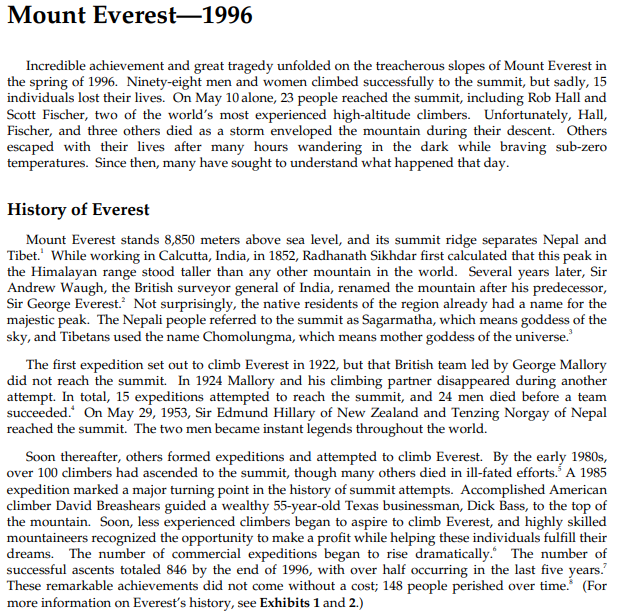
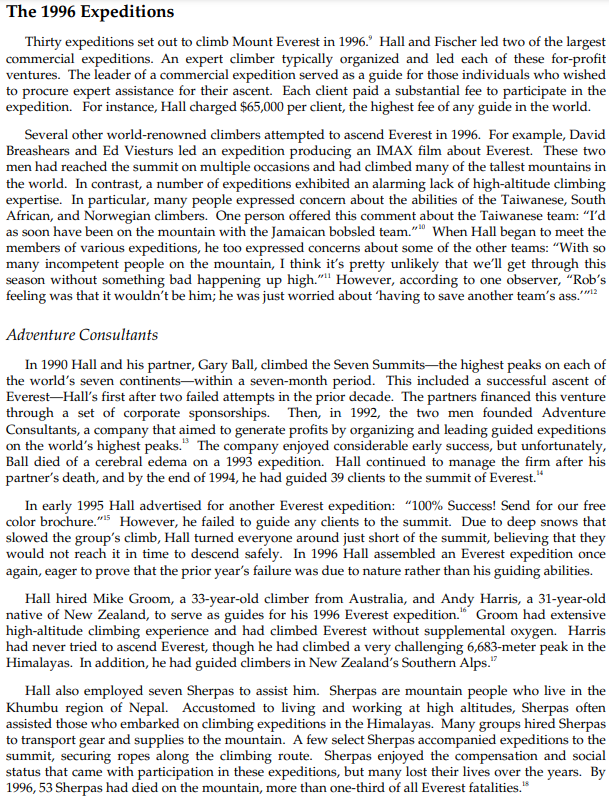

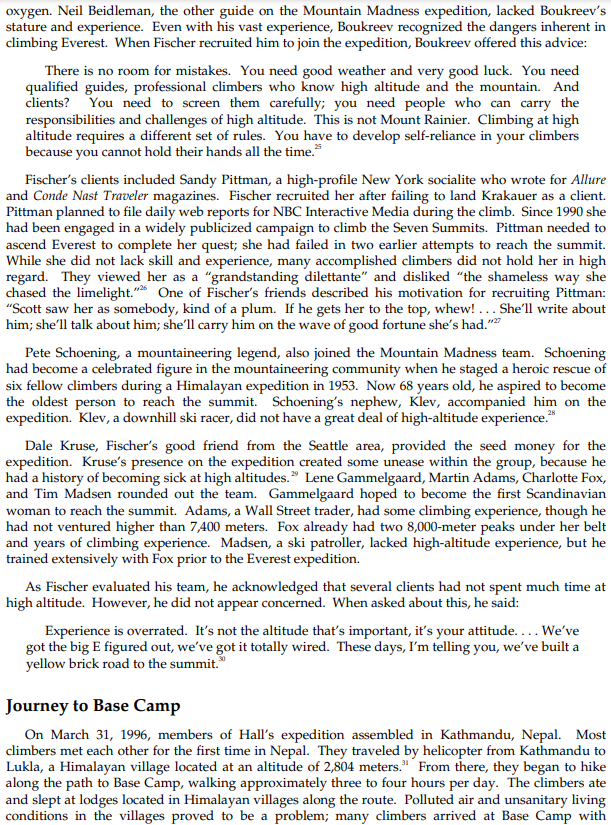
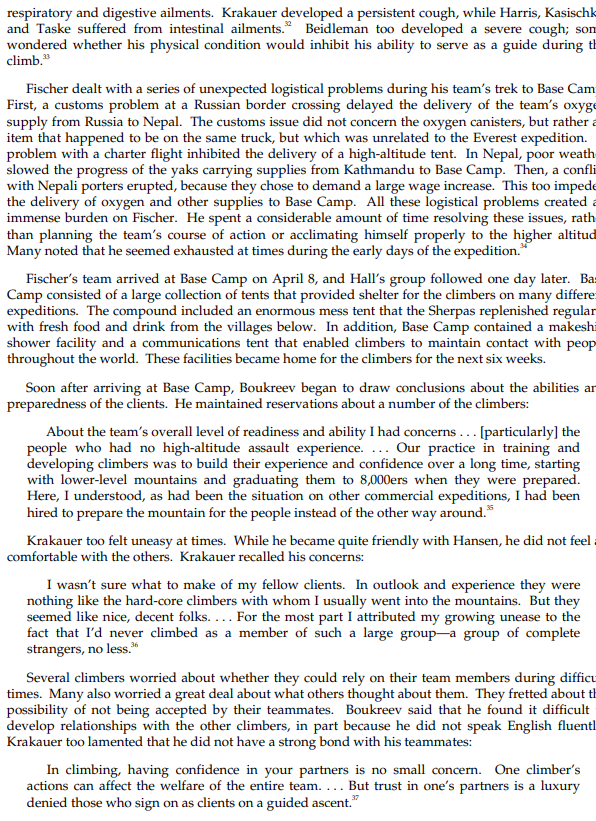
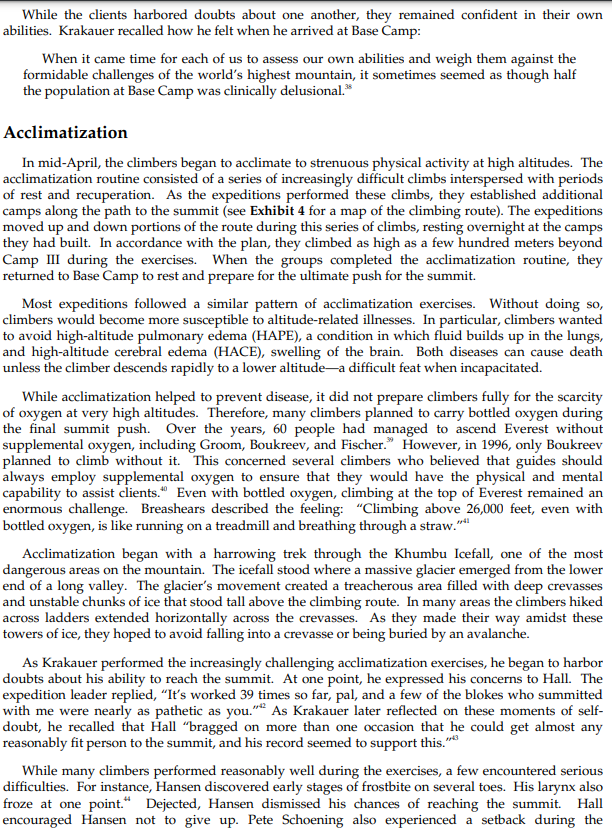
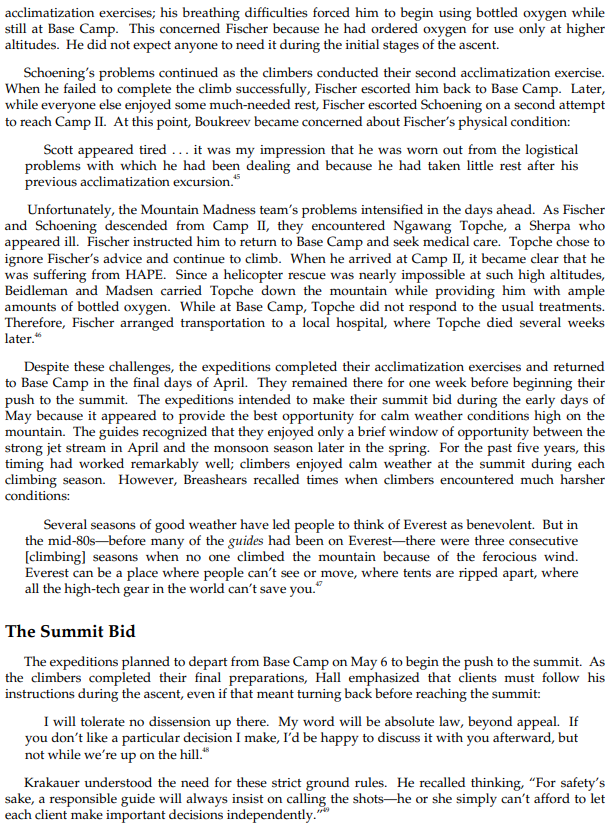
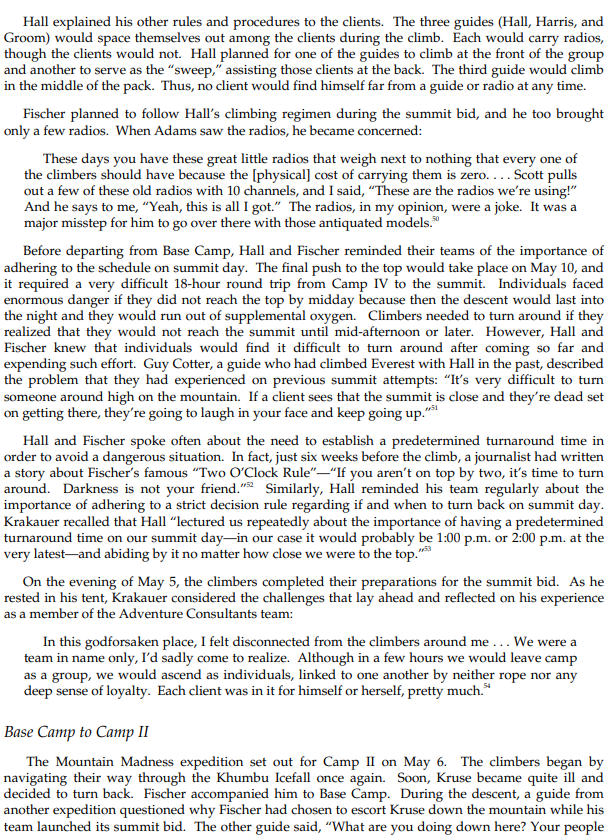
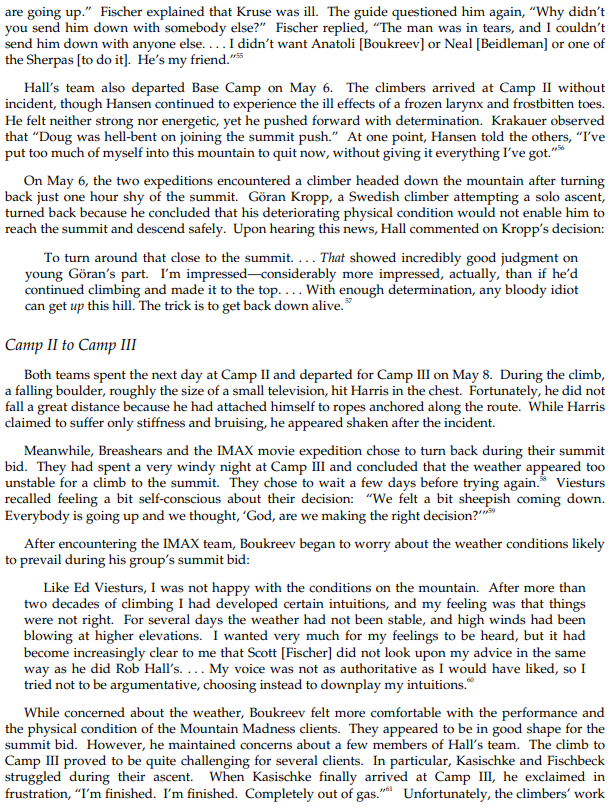
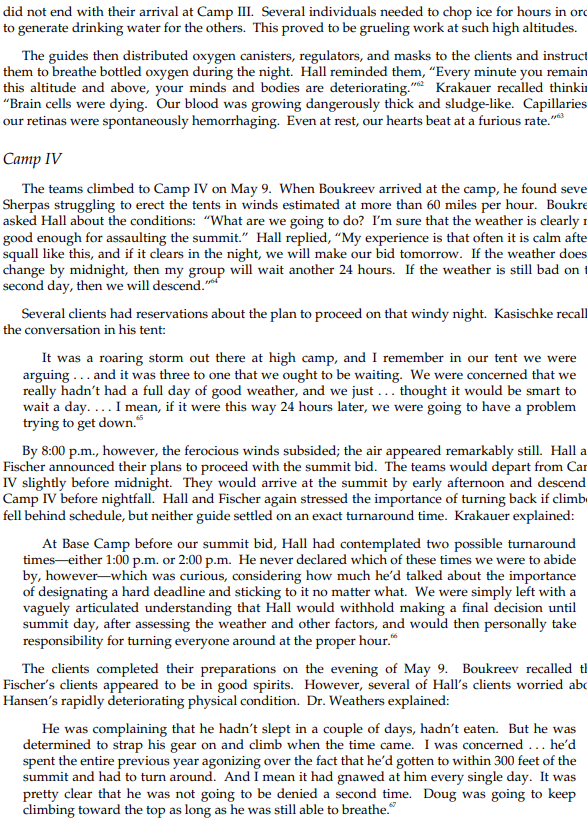
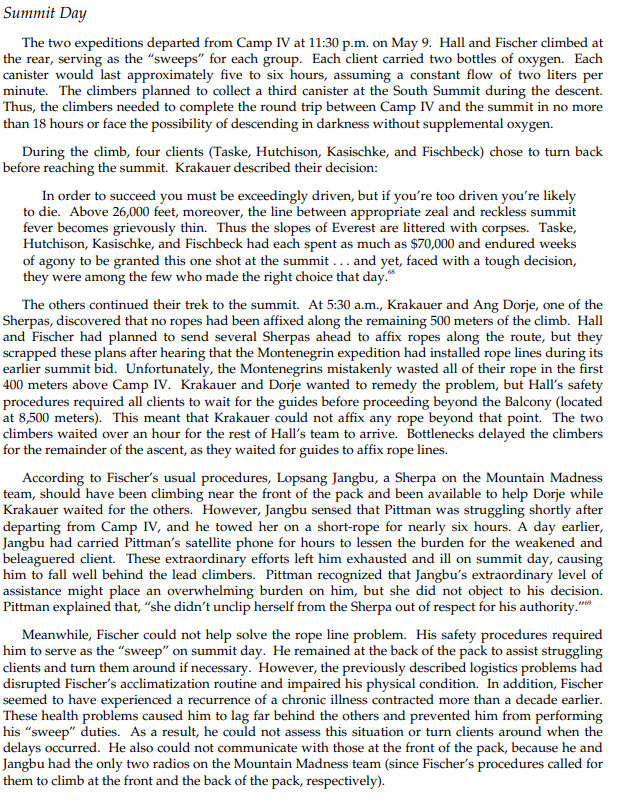
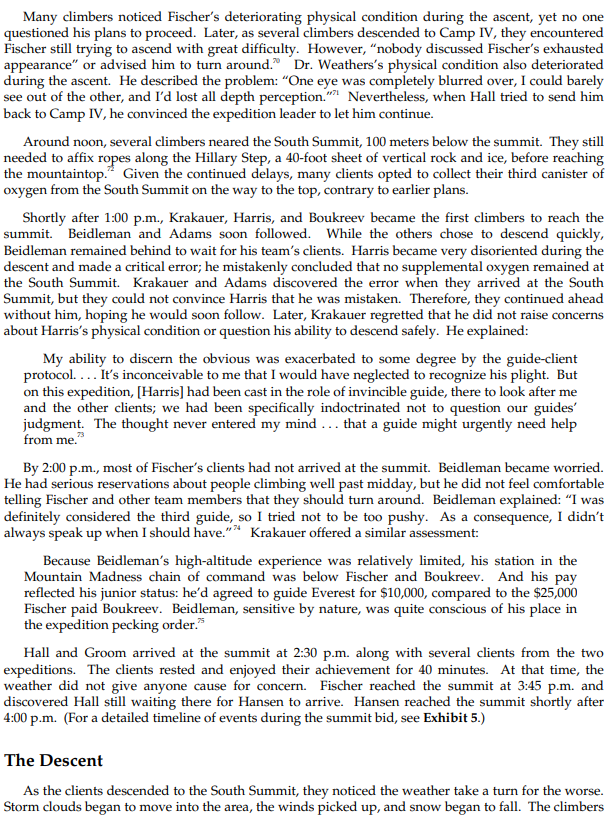


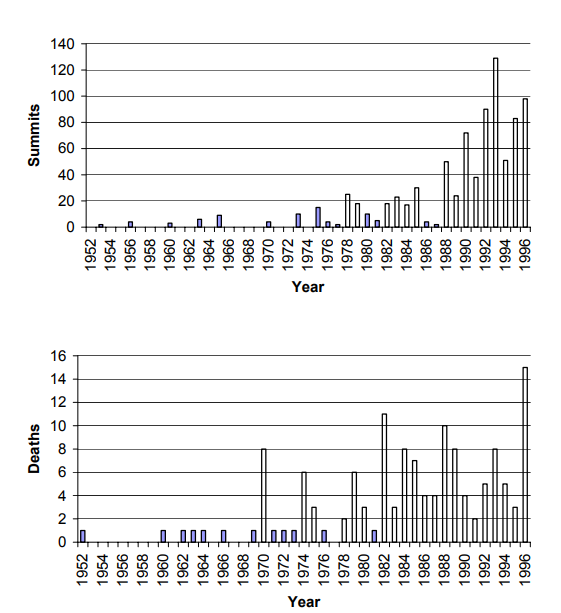
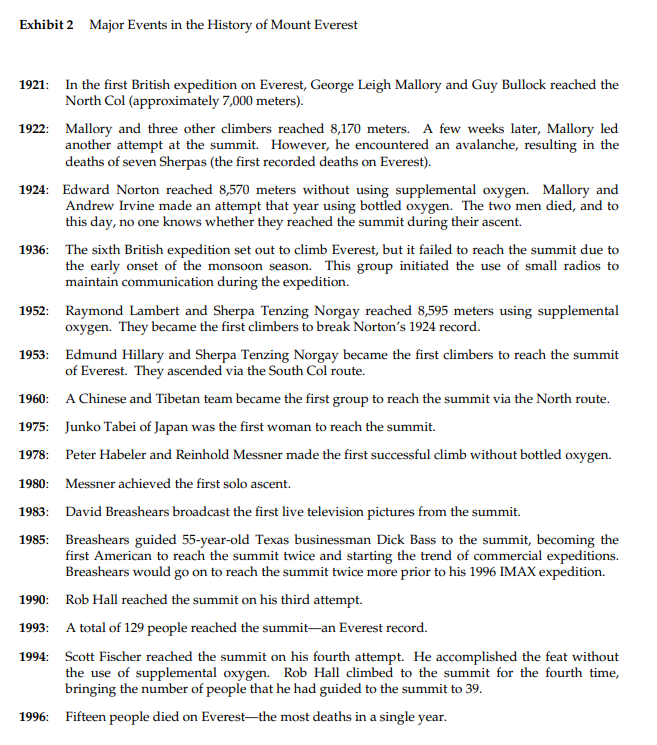


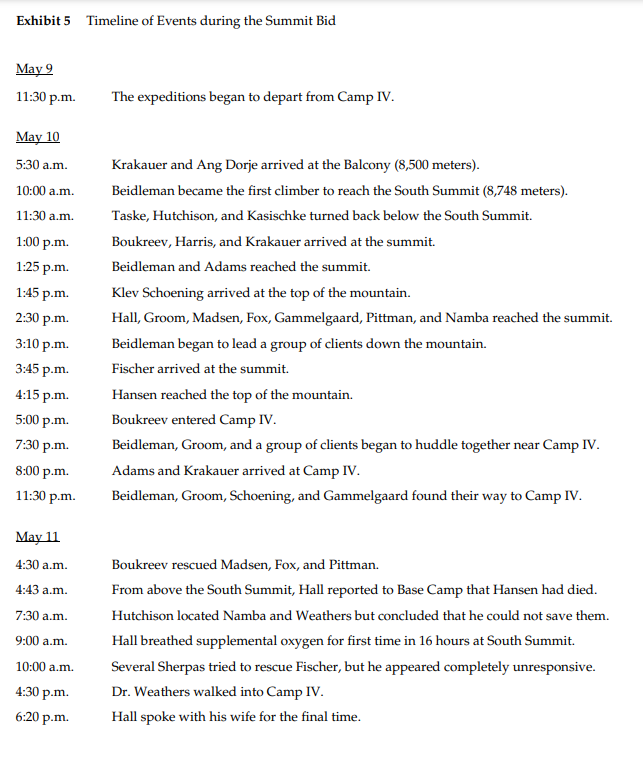
Incredible achievement and great tragedy unfolded on the treacherous slopes of Mount Everest in the spring of 1996. Ninety-eight men and women climbed successfully to the summit, but sadly, 15 individuals lost their lives. On May 10 alone, 23 people reached the summit, including Rob Hall and Scott Fischer, two of the world's most experienced high-altitude climbers. Unfortunately, Hall, Fischer, and three others died as a storm enveloped the mountain during their descent. Others escaped with their lives after many hours wandering in the dark while braving sub-zero temperatures. Since then, many have sought to understand what happened that day. History of Everest Mount Everest stands 8,850 meters above sea level, and its summit ridge separates Nepal and Tibet. ' While working in Calcutta, India, in 1852, Radhanath Sikhdar first calculated that this peak in the Himalayan range stood taller than any other mountain in the world. Several years later, Sir Andrew Waugh, the British surveyor general of India, renamed the mountain after his predecessor, Sir George Everest. 2 Not surprisingly, the native residents of the region already had a name for the majestic peak. The Nepali people referred to the summit as Sagarmatha, which means goddess of the sky, and Tibetans used the name Chomolungma, which means mother goddess of the universe. 3 The first expedition set out to climb Everest in 1922, but that British team led by George Mallory did not reach the summit. In 1924 Mallory and his climbing partner disappeared during another attempt. In total, 15 expeditions attempted to reach the summit, and 24 men died before a team succeeded. 4 On May 29, 1953, Sir Edmund Hillary of New Zealand and Tenzing Norgay of Nepal reached the summit. The two men became instant legends throughout the world. Soon thereafter, others formed expeditions and attempted to climb Everest. By the early 1980s, over 100 climbers had ascended to the summit, though many others died in ill-fated efforts.5 A 1985 expedition marked a major turning point in the history of summit attempts. Accomplished American climber David Breashears guided a wealthy 55-year-old Texas businessman, Dick Bass, to the top of the mountain. Soon, less experienced climbers began to aspire to climb Everest, and highly skilled mountaineers recognized the opportunity to make a profit while helping these individuals fulfill their dreams. The number of commercial expeditions began to rise dramatically. 6 The number of successful ascents totaled 846 by the end of 1996, with over half occurring in the last five years.? These remarkable achievements did not come without a cost; 148 people perished over time. 8 (For more information on Everest's history, see Exhibits 1 and 2 .) The 1996 Expeditions Thirty expeditions set out to climb Mount Everest in 1996." Hall and Fischer led two of the largest commercial expeditions. An expert climber typically organized and led each of these for-profit ventures. The leader of a commercial expedition served as a guide for those individuals who wished to procure expert assistance for their ascent. Each client paid a substantial fee to participate in the expedition. For instance, Hall charged $65,000 per client, the highest fee of any guide in the world. Several other world-renowned climbers attempted to ascend Everest in 1996. For example, David Breashears and Ed Viesturs led an expedition producing an IMAX film about Everest. These two men had reached the summit on multiple occasions and had climbed many of the tallest mountains in the world. In contrast, a number of expeditions exhibited an alarming lack of high-altitude climbing expertise. In particular, many people expressed concern about the abilities of the Taiwanese, South African, and Norwegian climbers. One person offered this comment about the Taiwanese team: "I'd as soon have been on the mountain with the Jamaican bobsled team.".10 When Hall began to meet the members of various expeditions, he too expressed concerns about some of the other teams: "With so many incompetent people on the mountain, I think it's pretty unlikely that we'll get through this season without something bad happening up high.." 11 However, according to one observer, "Rob's feeling was that it wouldn't be him; he was just worried about 'having to save another team's ass.'.m12 Adventure Consultants In 1990 Hall and his partner, Gary Ball, climbed the Seven Summits-the highest peaks on each of the world's seven continents-within a seven-month period. This included a successful ascent of Everest-Hall's first after two failed attempts in the prior decade. The partners financed this venture through a set of corporate sponsorships. Then, in 1992, the two men founded Adventure Consultants, a company that aimed to generate profits by organizing and leading guided expeditions on the world's highest peaks. 13 The company enjoyed considerable early success, but unfortunately, Ball died of a cerebral edema on a 1993 expedition. Hall continued to manage the firm after his partner's death, and by the end of 1994, he had guided 39 clients to the summit of Everest. 14 In early 1995 Hall advertised for another Everest expedition: "100\% Success! Send for our free color brochure. 115 However, he failed to guide any clients to the summit. Due to deep snows that slowed the group's climb, Hall turned everyone around just short of the summit, believing that they would not reach it in time to descend safely. In 1996 Hall assembled an Everest expedition once again, eager to prove that the prior year's failure was due to nature rather than his guiding abilities. Hall hired Mike Groom, a 33-year-old climber from Australia, and Andy Harris, a 31-year-old native of New Zealand, to serve as guides for his 1996 Everest expedition. 16 Groom had extensive high-altitude climbing experience and had climbed Everest without supplemental oxygen. Harris had never tried to ascend Everest, though he had climbed a very challenging 6,683-meter peak in the Himalayas. In addition, he had guided climbers in New Zealand's Southern Alps. 17 Hall also employed seven Sherpas to assist him. Sherpas are mountain people who live in the Khumbu region of Nepal. Accustomed to living and working at high altitudes, Sherpas often assisted those who embarked on climbing expeditions in the Himalayas. Many groups hired Sherpas to transport gear and supplies to the mountain. A few select Sherpas accompanied expeditions to the summit, securing ropes along the climbing route. Sherpas enjoyed the compensation and social status that came with participation in these expeditions, but many lost their lives over the years. By 1996, 53 Sherpas had died on the mountain, more than one-third of all Everest fatalities. 15 Adventure Consultants recruited eight clients to join the 1996 Everest expedition. None of the clients had ever completed a successful Everest ascent, nor had anyone climbed any other peak more than 8,000 meters high. Hall's roster included three doctors who aspired to climb Everest: Beck Weathers, Stuart Hutchison, and John Taske. Weathers, a Dallas pathologist, became convinced that he should attempt the climb after hearing about Bass's successful ascent. Weathers explained: Bass showed that Everest was within the realm of possibility for regular guys. Assuming you're reasonably fit and have some disposable income, I think the biggest obstacle is probably taking time off your job and leaving your family for two months. 19 Frank Fischbeck and Doug Hansen were returning to Everest after several unsuccessful attempts to reach the summit. Fischbeck had tried to climb Everest three separate times with another commercial guide, coming within just 330 vertical feet of the summit on one occasion. 20 Hansen, a member of the 1995 Adventure Consultants expedition, initially expressed reluctance about returning to Everest. However, Hall lobbied him personally, offering Hansen a discounted fee for the expedition. Hall felt very badly that he had been unable to guide Hansen to the summit in 1995 . Jon Krakauer, a journalist from Outside magazine, also joined the expedition through a special arrangement with Hall. For the past two years, Fischer had been trying to convince Krakauer to join one of his Everest expeditions. He believed that an article by Krakauer would provide great publicity for his fledging company. However, negotiations between Fischer and Outside magazine broke down in January 1996, and Hall made the editors a more attractive offer. He negotiated for advertising space in the magazine in exchange for Krakauer's expedition fees. An avid rock climber, Krakauer had little high-altitude experience. Before departing for Nepal, he assured his wife that he would not go much higher than Base Camp, which was located at an altitude of 5,364 meters. Lou Kasischke and Yasuko Namba rounded out the Adventure Consultants team. Unlike their fellow team members, these two clients had climbed six of the Seven Summits; only Everest had eluded them. Namba also was the only female in Hall's group. (For a complete list of the guides and clients on both the Hall and Fischer expeditions, see Exhibit 3.) Mountain Madness In 1984 Fischer founded Mountain Madness, a company that offered climbing instruction and guided expeditions. Over the years, Fischer had developed quite a reputation for his daring exploits. Those who met him often were struck by his ambition, charismatic personality, and desire for respect among his peers; his publicist noted, "Recognition was important to Scott. He ached for it. He had a vulnerable side that most people didn't see.".21 In 1994, on his fourth attempt, Fischer reached the summit of Everest without using supplemental oxygen. 2 Fischer also climbed several other 8,000meter peaks in the 1990s. Finally, in 1996, he decided to organize a commercial Everest expedition. An associate described Fischer's motivations for guiding Everest, "I think that he looked at Rob Hall's success and thought ... If he can do it, I can do it.."129 As Fischer departed for Nepal, a journalist asked him how his family felt about the risks of an Everest ascent. Fischer offered this reply: I believe 100 percent that I'm coming back. ... My wife believes 100 percent that I'm coming back. She isn't concerned about me at all when I'm guiding because I'm [going to] make all the right choices. When accidents happen, I think it's always human error. So that's what I want to eliminate. 24 Fischer employed two guides to assist clients on the expedition. Anatoli Boukreev was an accomplished high-altitude mountain climber and experienced guide from Russia. He had climbed seven of the world's most challenging mountains, including Everest, without the use of supplemental stature and experience. Even with his vast experience, Boukreev recognized the dangers inherent in climbing Everest. When Fischer recruited him to join the expedition, Boukreev offered this advice: There is no room for mistakes. You need good weather and very good luck. You need qualified guides, professional climbers who know high altitude and the mountain. And clients? You need to screen them carefully; you need people who can carry the responsibilities and challenges of high altitude. This is not Mount Rainier. Climbing at high altitude requires a different set of rules. You have to develop self-reliance in your climbers because you cannot hold their hands all the time. 25 Fischer's clients included Sandy Pittman, a high-profile New York socialite who wrote for Allure and Conde Nast Traveler magazines. Fischer recruited her after failing to land Krakauer as a client. Pittman planned to file daily web reports for NBC Interactive Media during the climb. Since 1990 she had been engaged in a widely publicized campaign to climb the Seven Summits. Pittman needed to ascend Everest to complete her quest; she had failed in two earlier attempts to reach the summit. While she did not lack skill and experience, many accomplished climbers did not hold her in high regard. They viewed her as a "grandstanding dilettante" and disliked "the shameless way she chased the limelight.".26 One of Fischer's friends described his motivation for recruiting Pittman: "Scott saw her as somebody, kind of a plum. If he gets her to the top, whew! ... She'll write about him; she'll talk about him; she'll carry him on the wave of good fortune she's had."127 Pete Schoening, a mountaineering legend, also joined the Mountain Madness team. Schoening had become a celebrated figure in the mountaineering community when he staged a heroic rescue of six fellow climbers during a Himalayan expedition in 1953. Now 68 years old, he aspired to become the oldest person to reach the summit. Schoening's nephew, Klev, accompanied him on the expedition. Klev, a downhill ski racer, did not have a great deal of high-altitude experience. 28 Dale Kruse, Fischer's good friend from the Seattle area, provided the seed money for the expedition. Kruse's presence on the expedition created some unease within the group, because he had a history of becoming sick at high altitudes. 29 Lene Gammelgaard, Martin Adams, Charlotte Fox, and Tim Madsen rounded out the team. Gammelgaard hoped to become the first Scandinavian woman to reach the summit. Adams, a Wall Street trader, had some climbing experience, though he had not ventured higher than 7,400 meters. Fox already had two 8,000-meter peaks under her belt and years of climbing experience. Madsen, a ski patroller, lacked high-altitude experience, but he trained extensively with Fox prior to the Everest expedition. As Fischer evaluated his team, he acknowledged that several clients had not spent much time at high altitude. However, he did not appear concerned. When asked about this, he said: Experience is overrated. It's not the altitude that's important, it's your attitude. ... We've got the big E figured out, we've got it totally wired. These days, I'm telling you, we've built a yellow brick road to the summit. Journey to Base Camp On March 31, 1996, members of Hall's expedition assembled in Kathmandu, Nepal. Most climbers met each other for the first time in Nepal. They traveled by helicopter from Kathmandu to Lukla, a Himalayan village located at an altitude of 2,804 meters. 31 From there, they began to hike along the path to Base Camp, walking approximately three to four hours per day. The climbers ate and slept at lodges located in Himalayan villages along the route. Polluted air and unsanitary living conditions in the villages proved to be a problem; many climbers arrived at Base Camp with respiratory and digestive ailments. Krakauer developed a persistent cough, while Harris, Kasischk and Taske suffered from intestinal ailments. .2 Beidleman too developed a severe cough; son wondered whether his physical condition would inhibit his ability to serve as a guide during th climb..33 Fischer dealt with a series of unexpected logistical problems during his team's trek to Base Cam First, a customs problem at a Russian border crossing delayed the delivery of the team's oxyge supply from Russia to Nepal. The customs issue did not concern the oxygen canisters, but rather item that happened to be on the same truck, but which was unrelated to the Everest expedition. problem with a charter flight inhibited the delivery of a high-altitude tent. In Nepal, poor weath slowed the progress of the yaks carrying supplies from Kathmandu to Base Camp. Then, a confli with Nepali porters erupted, because they chose to demand a large wage increase. This too impede the delivery of oxygen and other supplies to Base Camp. All these logistical problems created immense burden on Fischer. He spent a considerable amount of time resolving these issues, rath than planning the team's course of action or acclimating himself properly to the higher altitud Many noted that he seemed exhausted at times during the early days of the expedition." Fischer's team arrived at Base Camp on April 8, and Hall's group followed one day later. Ba: Camp consisted of a large collection of tents that provided shelter for the climbers on many differe expeditions. The compound included an enormous mess tent that the Sherpas replenished regular with fresh food and drink from the villages below. In addition, Base Camp contained a makesh shower facility and a communications tent that enabled climbers to maintain contact with peop throughout the world. These facilities became home for the climbers for the next six weeks. Soon after arriving at Base Camp, Boukreev began to draw conclusions about the abilities ar preparedness of the clients. He maintained reservations about a number of the climbers: About the team's overall level of readiness and ability I had concerns ... [particularly] the people who had no high-altitude assault experience. ... Our practice in training and developing climbers was to build their experience and confidence over a long time, starting with lower-level mountains and graduating them to 8,000ers when they were prepared. Here, I understood, as had been the situation on other commercial expeditions, I had been hired to prepare the mountain for the people instead of the other way around. 35 Krakauer too felt uneasy at times. While he became quite friendly with Hansen, he did not feel comfortable with the others. Krakauer recalled his concerns: I wasn't sure what to make of my fellow clients. In outlook and experience they were nothing like the hard-core climbers with whom I usually went into the mountains. But they seemed like nice, decent folks. ... For the most part I attributed my growing unease to the fact that I'd never climbed as a member of such a large group-a group of complete strangers, no less. 36 Several climbers worried about whether they could rely on their team members during diffict times. Many also worried a great deal about what others thought about them. They fretted about th possibility of not being accepted by their teammates. Boukreev said that he found it difficult develop relationships with the other climbers, in part because he did not speak English fluentl Krakauer too lamented that he did not have a strong bond with his teammates: In climbing, having confidence in your partners is no small concern. One climber's actions can affect the welfare of the entire team. ... But trust in one's partners is a luxury denied those who sign on as clients on a guided ascent. 37 While the clients harbored doubts about one another, they remained confident in their own abilities. Krakauer recalled how he felt when he arrived at Base Camp: When it came time for each of us to assess our own abilities and weigh them against the formidable challenges of the world's highest mountain, it sometimes seemed as though half the population at Base Camp was clinically delusional. 38 Acclimatization In mid-April, the climbers began to acclimate to strenuous physical activity at high altitudes. The acclimatization routine consisted of a series of increasingly difficult climbs interspersed with periods of rest and recuperation. As the expeditions performed these climbs, they established additional camps along the path to the summit (see Exhibit 4 for a map of the climbing route). The expeditions moved up and down portions of the route during this series of climbs, resting overnight at the camps they had built. In accordance with the plan, they climbed as high as a few hundred meters beyond Camp III during the exercises. When the groups completed the acclimatization routine, they returned to Base Camp to rest and prepare for the ultimate push for the summit. Most expeditions followed a similar pattern of acclimatization exercises. Without doing so, climbers would become more susceptible to altitude-related illnesses. In particular, climbers wanted to avoid high-altitude pulmonary edema (HAPE), a condition in which fluid builds up in the lungs, and high-altitude cerebral edema (HACE), swelling of the brain. Both diseases can cause death unless the climber descends rapidly to a lower altitude-a difficult feat when incapacitated. While acclimatization helped to prevent disease, it did not prepare climbers fully for the scarcity of oxygen at very high altitudes. Therefore, many climbers planned to carry bottled oxygen during the final summit push. Over the years, 60 people had managed to ascend Everest without supplemental oxygen, including Groom, Boukreev, and Fischer." However, in 1996, only Boukreev planned to climb without it. This concerned several climbers who believed that guides should always employ supplemental oxygen to ensure that they would have the physical and mental capability to assist clients. 40 Even with bottled oxygen, climbing at the top of Everest remained an enormous challenge. Breashears described the feeling: "Climbing above 26,000 feet, even with bottled oxygen, is like running on a treadmill and breathing through a straw.,.41 Acclimatization began with a harrowing trek through the Khumbu Icefall, one of the most dangerous areas on the mountain. The icefall stood where a massive glacier emerged from the lower end of a long valley. The glacier's movement created a treacherous area filled with deep crevasses and unstable chunks of ice that stood tall above the climbing route. In many areas the climbers hiked across ladders extended horizontally across the crevasses. As they made their way amidst these towers of ice, they hoped to avoid falling into a crevasse or being buried by an avalanche. As Krakauer performed the increasingly challenging acclimatization exercises, he began to harbor doubts about his ability to reach the summit. At one point, he expressed his concerns to Hall. The expedition leader replied, "It's worked 39 times so far, pal, and a few of the blokes who summitted with me were nearly as pathetic as you.,." ,22 As Krakauer later reflected on these moments of selfdoubt, he recalled that Hall "bragged on more than one occasion that he could get almost any reasonably fit person to the summit, and his record seemed to support this.."13 While many climbers performed reasonably well during the exercises, a few encountered serious difficulties. For instance, Hansen discovered early stages of frostbite on several toes. His larynx also froze at one point. 4 Dejected, Hansen dismissed his chances of reaching the summit. Hall acclimatization exercises; his breathing difficulties forced him to begin using bottled oxygen while still at Base Camp. This concerned Fischer because he had ordered oxygen for use only at higher altitudes. He did not expect anyone to need it during the initial stages of the ascent. Schoening's problems continued as the climbers conducted their second acclimatization exercise. When he failed to complete the climb successfully, Fischer escorted him back to Base Camp. Later, while everyone else enjoyed some much-needed rest, Fischer escorted Schoening on a second attempt to reach Camp II. At this point, Boukreev became concerned about Fischer's physical condition: Scott appeared tired ... it was my impression that he was worn out from the logistical problems with which he had been dealing and because he had taken little rest after his previous acclimatization excursion. 45 Unfortunately, the Mountain Madness team's problems intensified in the days ahead. As Fischer and Schoening descended from Camp II, they encountered Ngawang Topche, a Sherpa who appeared ill. Fischer instructed him to return to Base Camp and seek medical care. Topche chose to ignore Fischer's advice and continue to climb. When he arrived at Camp II, it became clear that he was suffering from HAPE. Since a helicopter rescue was nearly impossible at such high altitudes, Beidleman and Madsen carried Topche down the mountain while providing him with ample amounts of bottled oxygen. While at Base Camp, Topche did not respond to the usual treatments. Therefore, Fischer arranged transportation to a local hospital, where Topche died several weeks later. t6 Despite these challenges, the expeditions completed their acclimatization exercises and returned to Base Camp in the final days of April. They remained there for one week before beginning their push to the summit. The expeditions intended to make their summit bid during the early days of May because it appeared to provide the best opportunity for calm weather conditions high on the mountain. The guides recognized that they enjoyed only a brief window of opportunity between the strong jet stream in April and the monsoon season later in the spring. For the past five years, this timing had worked remarkably well; climbers enjoyed calm weather at the summit during each climbing season. However, Breashears recalled times when climbers encountered much harsher conditions: Several seasons of good weather have led people to think of Everest as benevolent. But in the mid- 80 s - before many of the guides had been on Everest-there were three consecutive [climbing] seasons when no one climbed the mountain because of the ferocious wind. Everest can be a place where people can't see or move, where tents are ripped apart, where all the high-tech gear in the world can't save you. t The Summit Bid The expeditions planned to depart from Base Camp on May 6 to begin the push to the summit. As the climbers completed their final preparations, Hall emphasized that clients must follow his instructions during the ascent, even if that meant turning back before reaching the summit: I will tolerate no dissension up there. My word will be absolute law, beyond appeal. If you don't like a particular decision I make, I'd be happy to discuss it with you afterward, but not while we're up on the hill. 48 Krakauer understood the need for these strict ground rules. He recalled thinking, "For safety's sake, a responsible guide will always insist on calling the shots-he or she simply can't afford to let each client make important decisions independently.." exples the guides (Hall, Harris, and though the clients would not. Hall planned for one of the guides to climb at the front of the group and another to serve as the "sweep," assisting those clients at the back. The third guide would climb in the middle of the pack. Thus, no client would find himself far from a guide or radio at any time. Fischer planned to follow Hall's climbing regimen during the summit bid, and he too brought only a few radios. When Adams saw the radios, he became concerned: These days you have these great little radios that weigh next to nothing that every one of the climbers should have because the [physical] cost of carrying them is zero. ... Scott pulls out a few of these old radios with 10 channels, and I said, "These are the radios we're using!" And he says to me, "Yeah, this is all I got." The radios, in my opinion, were a joke. It was a major misstep for him to go over there with those antiquated models. 50 Before departing from Base Camp, Hall and Fischer reminded their teams of the importance of adhering to the schedule on summit day. The final push to the top would take place on May 10, and it required a very difficult 18 -hour round trip from Camp IV to the summit. Individuals faced enormous danger if they did not reach the top by midday because then the descent would last into the night and they would run out of supplemental oxygen. Climbers needed to turn around if they realized that they would not reach the summit until mid-afternoon or later. However, Hall and Fischer knew that individuals would find it difficult to turn around after coming so far and expending such effort. Guy Cotter, a guide who had climbed Everest with Hall in the past, described the problem that they had experienced on previous summit attempts: "It's very difficult to turn someone around high on the mountain. If a client sees that the summit is close and they're dead set on getting there, they're going to laugh in your face and keep going up.".51 Hall and Fischer spoke often about the need to establish a predetermined turnaround time in order to avoid a dangerous situation. In fact, just six weeks before the climb, a journalist had written a story about Fischer's famous "Two O'Clock Rule"- "If you aren't on top by two, it's time to turn around. Darkness is not your friend..52 Similarly, Hall reminded his team regularly about the importance of adhering to a strict decision rule regarding if and when to turn back on summit day. Krakauer recalled that Hall "lectured us repeatedly about the importance of having a predetermined turnaround time on our summit day-in our case it would probably be 1:00 p.m. or 2:00 p.m. at the very latest-and abiding by it no matter how close we were to the top." On the evening of May 5, the climbers completed their preparations for the summit bid. As he rested in his tent, Krakauer considered the challenges that lay ahead and reflected on his experience as a member of the Adventure Consultants team: In this godforsaken place, I felt disconnected from the climbers around me ... We were a team in name only, I'd sadly come to realize. Although in a few hours we would leave camp as a group, we would ascend as individuals, linked to one another by neither rope nor any deep sense of loyalty. Each client was in it for himself or herself, pretty much. 54 Base Camp to Camp II The Mountain Madness expedition set out for Camp II on May 6. The climbers began by navigating their way through the Khumbu Icefall once again. Soon, Kruse became quite ill and decided to turn back. Fischer accompanied him to Base Camp. During the descent, a guide from another expedition questioned why Fischer had chosen to escort Kruse down the mountain while his team launched its summit bid. The other guide said, "What are you doing down here? Your people are going up." Fischer explained that Kruse was ill. The guide questioned him again, "Why didn't you send him down with somebody else?" Fischer replied, "The man was in tears, and I couldn't send him down with anyone else. ... I didn't want Anatoli [Boukreev] or Neal [Beidleman] or one of the Sherpas [to do it]. He's my friend..55 Hall's team also departed Base Camp on May 6. The climbers arrived at Camp II without incident, though Hansen continued to experience the ill effects of a frozen larynx and frostbitten toes. He felt neither strong nor energetic, yet he pushed forward with determination. Krakauer observed that "Doug was hell-bent on joining the summit push." At one point, Hansen told the others, "I've put too much of myself into this mountain to quit now, without giving it everything I've got.".56 On May 6, the two expeditions encountered a climber headed down the mountain after turning back just one hour shy of the summit. Gran Kropp, a Swedish climber attempting a solo ascent, turned back because he concluded that his deteriorating physical condition would not enable him to reach the summit and descend safely. Upon hearing this news, Hall commented on Kropp's decision: To turn around that close to the summit. ... That showed incredibly good judgment on young Gran's part. I'm impressed-considerably more impressed, actually, than if he'd continued climbing and made it to the top.... With enough determination, any bloody idiot can get up this hill. The trick is to get back down alive. 50 Camp II to Camp III Both teams spent the next day at Camp II and departed for Camp III on May 8. During the climb, a falling boulder, roughly the size of a small television, hit Harris in the chest. Fortunately, he did not fall a great distance because he had attached himself to ropes anchored along the route. While Harris claimed to suffer only stiffness and bruising, he appeared shaken after the incident. Meanwhile, Breashears and the IMAX movie expedition chose to turn back during their summit bid. They had spent a very windy night at Camp III and concluded that the weather appeared too unstable for a climb to the summit. They chose to wait a few days before trying again. 58 Viesturs recalled feeling a bit self-conscious about their decision: "We felt a bit sheepish coming down. Everybody is going up and we thought, 'God, are we making the right decision?',ns After encountering the IMAX team, Boukreev began to worry about the weather conditions likely to prevail during his group's summit bid: Like Ed Viesturs, I was not happy with the conditions on the mountain. After more than two decades of climbing I had developed certain intuitions, and my feeling was that things were not right. For several days the weather had not been stable, and high winds had been blowing at higher elevations. I wanted very much for my feelings to be heard, but it had become increasingly clear to me that Scott [Fischer] did not look upon my advice in the same way as he did Rob Hall's. ... My voice was not as authoritative as I would have liked, so I tried not to be argumentative, choosing instead to downplay my intuitions. 60 While concerned about the weather, Boukreev felt more comfortable with the performance and the physical condition of the Mountain Madness clients. They appeared to be in good shape for the summit bid. However, he maintained concerns about a few members of Hall's team. The climb to Camp III proved to be quite challenging for several clients. In particular, Kasischke and Fischbeck struggled during their ascent. When Kasischke finally arrived at Camp III, he exclaimed in Summit Day The two expeditions departed from Camp IV at 11:30 p.m. on May 9. Hall and Fischer climbed at the rear, serving as the "sweeps" for each group. Each client carried two bottles of oxygen. Each canister would last approximately five to six hours, assuming a constant flow of two liters per minute. The climbers planned to collect a third canister at the South Summit during the descent. Thus, the climbers needed to complete the round trip between Camp IV and the summit in no more than 18 hours or face the possibility of descending in darkness without supplemental oxygen. During the climb, four clients (Taske, Hutchison, Kasischke, and Fischbeck) chose to turn back before reaching the summit. Krakauer described their decision: In order to succeed you must be exceedingly driven, but if you're too driven you're likely to die. Above 26,000 feet, moreover, the line between appropriate zeal and reckless summit fever becomes grievously thin. Thus the slopes of Everest are littered with corpses. Taske, Hutchison, Kasischke, and Fischbeck had each spent as much as $70,000 and endured weeks of agony to be granted this one shot at the summit ... and yet, faced with a tough decision, they were among the few who made the right choice that day. 68 The others continued their trek to the summit. At 5:30 a.m., Krakauer and Ang Dorje, one of the Sherpas, discovered that no ropes had been affixed along the remaining 500 meters of the climb. Hall and Fischer had planned to send several Sherpas ahead to affix ropes along the route, but they scrapped these plans after hearing that the Montenegrin expedition had installed rope lines during its earlier summit bid. Unfortunately, the Montenegrins mistakenly wasted all of their rope in the first 400 meters above Camp IV. Krakauer and Dorje wanted to remedy the problem, but Hall's safety procedures required all clients to wait for the guides before proceeding beyond the Balcony (located at 8,500 meters). This meant that Krakauer could not affix any rope beyond that point. The two climbers waited over an hour for the rest of Hall's team to arrive. Bottlenecks delayed the climbers for the remainder of the ascent, as they waited for guides to affix rope lines. According to Fischer's usual procedures, Lopsang Jangbu, a Sherpa on the Mountain Madness team, should have been climbing near the front of the pack and been available to help Dorje while Krakauer waited for the others. However, Jangbu sensed that Pittman was struggling shortly after departing from Camp IV, and he towed her on a short-rope for nearly six hours. A day earlier, Jangbu had carried Pittman's satellite phone for hours to lessen the burden for the weakened and beleaguered client. These extraordinary efforts left him exhausted and ill on summit day, causing him to fall well behind the lead climbers. Pittman recognized that Jangbu's extraordinary level of assistance might place an overwhelming burden on him, but she did not object to his decision. Pittman explained that, "she didn't unclip herself from the Sherpa out of respect for his authority. .t* Meanwhile, Fischer could not help solve the rope line problem. His safety procedures required him to serve as the "sweep" on summit day. He remained at the back of the pack to assist struggling clients and turn them around if necessary. However, the previously described logistics problems had disrupted Fischer's acclimatization routine and impaired his physical condition. In addition, Fischer seemed to have experienced a recurrence of a chronic illness contracted more than a decade earlier. These health problems caused him to lag far behind the others and prevented him from performing his "sweep" duties. As a result, he could not assess this situation or turn clients around when the delays occurred. He also could not communicate with those at the front of the pack, because he and Jangbu had the only two radios on the Mountain Madness team (since Fischer's procedures called for them to climb at the front and the back of the pack, respectively). Many climbers noticed Fischer's deteriorating physical condition during the ascent, yet no one questioned his plans to proceed. Later, as several climbers descended to Camp IV, they encountered Fischer still trying to ascend with great difficulty. However, "nobody discussed Fischer's exhausted appearance" or advised him to turn around." Dr. Weathers's physical condition also deteriorated during the ascent. He described the problem: "One eye was completely blurred over, I could barely see out of the other, and I'd lost all depth perception.".71 Nevertheless, when Hall tried to send him back to Camp IV, he convinced the expedition leader to let him continue. Around noon, several climbers neared the South Summit, 100 meters below the summit. They still needed to affix ropes along the Hillary Step, a 40 -foot sheet of vertical rock and ice, before reaching the mountaintop. 72 Given the continued delays, many clients opted to collect their third canister of oxygen from the South Summit on the way to the top, contrary to earlier plans. Shortly after 1:00 p.m., Krakauer, Harris, and Boukreev became the first climbers to reach the summit. Beidleman and Adams soon followed. While the others chose to descend quickly, Beidleman remained behind to wait for his team's clients. Harris became very disoriented during the descent and made a critical error; he mistakenly concluded that no supplemental oxygen remained at the South Summit. Krakauer and Adams discovered the error when they arrived at the South Summit, but they could not convince Harris that he was mistaken. Therefore, they continued ahead without him, hoping he would soon follow. Later, Krakauer regretted that he did not raise concerns about Harris's physical condition or question his ability to descend safely. He explained: My ability to discern the obvious was exacerbated to some degree by the guide-client protocol. ... It's inconceivable to me that I would have neglected to recognize his plight. But on this expedition, [Harris] had been cast in the role of invincible guide, there to look after me and the other clients; we had been specifically indoctrinated not to question our guides' judgment. The thought never entered my mind ... that a guide might urgently need help from me. By 2:00 p.m., most of Fischer's clients had not arrived at the summit. Beidleman became worried. He had serious reservations about people climbing well past midday, but he did not feel comfortable telling Fischer and other team members that they should turn around. Beidleman explained: "I was definitely considered the third guide, so I tried not to be too pushy. As a consequence, I didn't always speak up when I should have." 74 Krakauer offered a similar assessment: Because Beidleman's high-altitude experience was relatively limited, his station in the Mountain Madness chain of command was below Fischer and Boukreev. And his pay reflected his junior status: he'd agreed to guide Everest for $10,000, compared to the $25,000 Fischer paid Boukreev. Beidleman, sensitive by nature, was quite conscious of his place in the expedition pecking order. 73 Hall and Groom arrived at the summit at 2:30 p.m. along with several clients from the two expeditions. The clients rested and enjoyed their achievement for 40 minutes. At that time, the weather did not give anyone cause for concern. Fischer reached the summit at 3:45 p.m. and discovered Hall still waiting there for Hansen to arrive. Hansen reached the summit shortly after 4:00 p.m. (For a detailed timeline of events during the summit bid, see Exhibit 5.) The Descent As the clients descended to the South Summit, they noticed the weather take a turn for the worse. Storm clouds began to move into the area, the winds picked up, and snow began to fall. The climbers They discovered him barely alive. The Sherpas provided him oxygen, but soon they concluded that they could not assist him. They left him and returned to Camp IV. No one ever saw Fischer again. Later that afternoon, Dr. Weathers shocked his teammates when he walked into Camp IV. Left for dead, he had somehow regained his strength and found his way back to the camp. Amazingly, Hall also survived throughout the afternoon, alone high on the mountain. At 6:20 p.m., Hall spoke with his wife, who had been patched through to his radio from the satellite phone at Base Camp. He told her, "I love you. Sleep well, my sweetheart. Please don't worry too much." Sadly, no one spoke with Hall again after that emotional phone call. On the morning of May 12, the climbers awoke to a grim realization. Five of their fellow climbers would never return; Hall, Fischer, Hansen, Namba, and Harris had died. Distraught and exhausted, the survivors began their descent to Base Camp. Reflecting Back Since 1996, many people have analyzed the decisions that Hall and Fischer made during their ascent, and they have cited a number of possible causes of the tragedy. Competing theories abound, and much disagreement remains among survivors and other expert climbers. Some individuals, such as Krakauer, recognized that mistakes may have been made, but they emphasized that climbing Everest will always be a risky and dangerous endeavor. After all, storms, avalanches, and collapses of large chunks of ice have caused many deaths over the years. This school of thought emphasized the inevitability of failure and tragedy on the slopes of Everest. Krakauer explained: Analyzing what went wrong on Everest is a useful enough enterprise; it might conceivably prevent some deaths down the road. But to believe that dissecting the tragic events of 1996 in minute detail will actually reduce the future death rate in any meaningful way is wishful thinking. The urge to catalog the myriad blunders in order to "learn from the mistakes" is for the most part an exercise in denial and self-deception. If you can convince yourself that Rob Hall died because he made a string of stupid errors and that you are too clever to repeat those same errors, it makes it easier for you to attempt Everest in the face of some rather compelling evidence that doing so is injudicious. Truth be told, climbing Everest has always been an extraordinarily dangerous undertaking and doubtless always will be ... the strongest guides in the world are sometimes powerless to save even their own lives. Four of my teammates died not so much because Rob Hall's systems were faultyindeed, nobody's were better-but because on Everest it is the nature of systems to break down with a vengeance. 81 Others have argued that human error caused the tragedy, and therefore, these deaths could have been prevented. They point to a series of crucial mistakes that Hall and Fischer made during the expedition. One accomplished guide put it rather bluntly: "The events of May 10 were not an accident, nor an act of God. They were the end result of people who were making decisions about how and whether to proceed. 2 Boukreev acknowledged that the teams made critical errors during the climb. However, he disagreed with those who sought to identify one predominant factor at the root of the tragedy. He concluded, "To cite a specific cause would be to promote an omniscience that only gods, drunks, Exhibit 2 Major Events in the History of Mount Everest 1921: In the first British expedition on Everest, George Leigh Mallory and Guy Bullock reached the North Col (approximately 7,000 meters). 1922: Mallory and three other climbers reached 8,170 meters. A few weeks later, Mallory led another attempt at the summit. However, he encountered an avalanche, resulting in the deaths of seven Sherpas (the first recorded deaths on Everest). 1924: Edward Norton reached 8,570 meters without using supplemental oxygen. Mallory and Andrew Irvine made an attempt that year using bottled oxygen. The two men died, and to this day, no one knows whether they reached the summit during their ascent. 1936: The sixth British expedition set out to climb Everest, but it failed to reach the summit due to the early onset of the monsoon season. This group initiated the use of small radios to maintain communication during the expedition. 1952: Raymond Lambert and Sherpa Tenzing Norgay reached 8,595 meters using supplemental oxygen. They became the first climbers to break Norton's 1924 record. 1953: Edmund Hillary and Sherpa Tenzing Norgay became the first climbers to reach the summit of Everest. They ascended via the South Col route. 1960: A Chinese and Tibetan team became the first group to reach the summit via the North route. 1975: Junko Tabei of Japan was the first woman to reach the summit. 1978: Peter Habeler and Reinhold Messner made the first successful climb without bottled oxygen. 1980: Messner achieved the first solo ascent. 1983: David Breashears broadcast the first live television pictures from the summit. 1985: Breashears guided 55-year-old Texas businessman Dick Bass to the summit, becoming the first American to reach the summit twice and starting the trend of commercial expeditions. Breashears would go on to reach the summit twice more prior to his 1996 IMAX expedition. 1990: Rob Hall reached the summit on his third attempt. 1993: A total of 129 people reached the summit-an Everest record. 1994: Scott Fischer reached the summit on his fourth attempt. He accomplished the feat without the use of supplemental oxygen. Rob Hall climbed to the summit for the fourth time, bringing the number of people that he had guided to the summit to 39. 1996: Fifteen people died on Everest-the most deaths in a single year. Exhibit 3 Mountain Madness and Adventure Consultants Expeditions Exhibit 4 Mount Everest MapSouth Col Route Exhibit 5 Timeline of Events during the Summit Bid May9 11:30 p.m. The expeditions began to depart from Camp IV. May 10 5:30 a.m. Krakauer and Ang Dorje arrived at the Balcony ( 8,500 meters). 10:00 a.m. Beidleman became the first climber to reach the South Summit (8,748 meters). 11:30 a.m. Taske, Hutchison, and Kasischke turned back below the South Summit. 1:00 p.m. Boukreev, Harris, and Krakauer arrived at the summit. 1:25 p.m. Beidleman and Adams reached the summit. 1:45 p.m. Klev Schoening arrived at the top of the mountain. 2:30 p.m. Hall, Groom, Madsen, Fox, Gammelgaard, Pittman, and Namba reached the summit. 3:10 p.m. Beidleman began to lead a group of clients down the mountain. 3:45 p.m. Fischer arrived at the summit. 4:15 p.m. Hansen reached the top of the mountain. 5:00 p.m. Boukreev entered Camp IV. 7:30 p.m. Beidleman, Groom, and a group of clients began to huddle together near Camp IV. 8:00 p.m. Adams and Krakauer arrived at Camp IV. 11:30 p.m. Beidleman, Groom, Schoening, and Gammelgaard found their way to Camp IV. May 11 4:30 a.m. Boukreev rescued Madsen, Fox, and Pittman. 4:43 a.m. From above the South Summit, Hall reported to Base Camp that Hansen had died. 7:30 a.m. Hutchison located Namba and Weathers but concluded that he could not save them. 9:00 a.m. Hall breathed supplemental oxygen for first time in 16 hours at South Summit. 10:00 a.m. Several Sherpas tried to rescue Fischer, but he appeared completely unresponsive. 4:30 p.m. Dr. Weathers walked into Camp IV. 6:20 p.m. Hall spoke with his wife for the final time
Step by Step Solution
There are 3 Steps involved in it
Step: 1

Get Instant Access to Expert-Tailored Solutions
See step-by-step solutions with expert insights and AI powered tools for academic success
Step: 2

Step: 3

Ace Your Homework with AI
Get the answers you need in no time with our AI-driven, step-by-step assistance
Get Started


